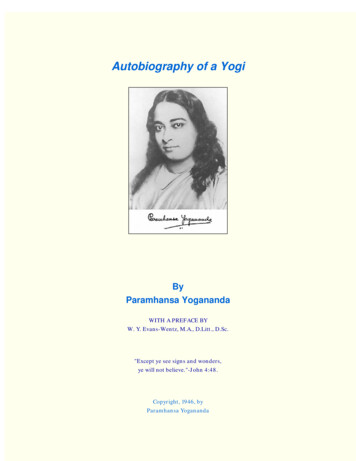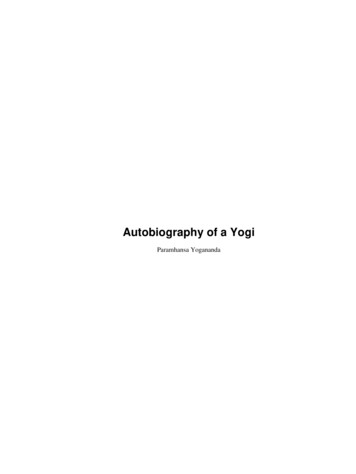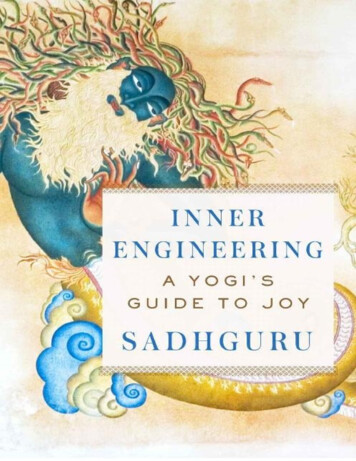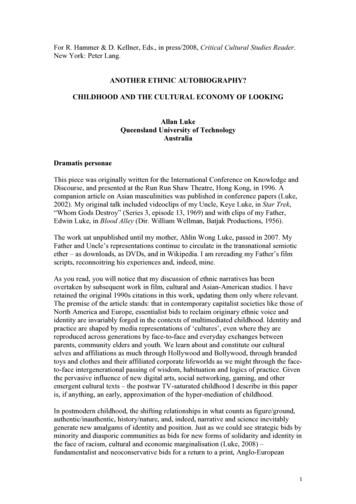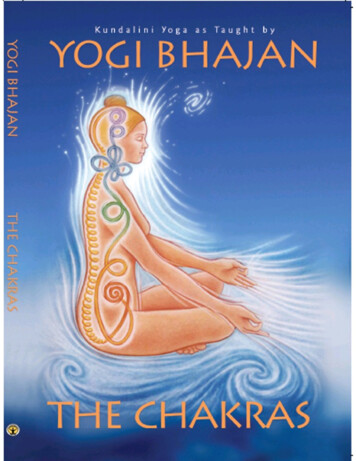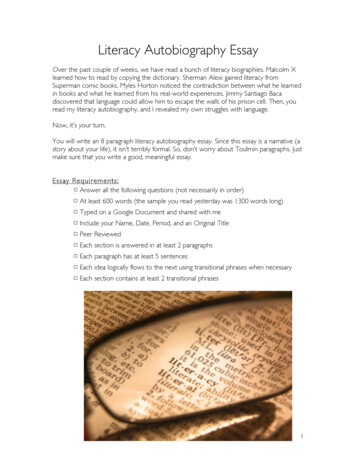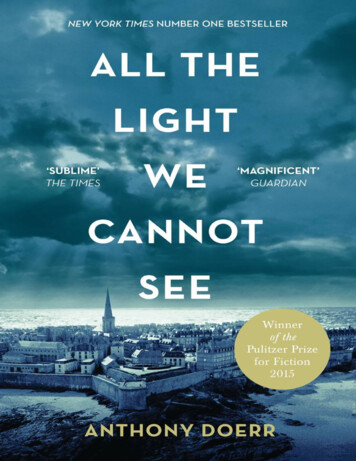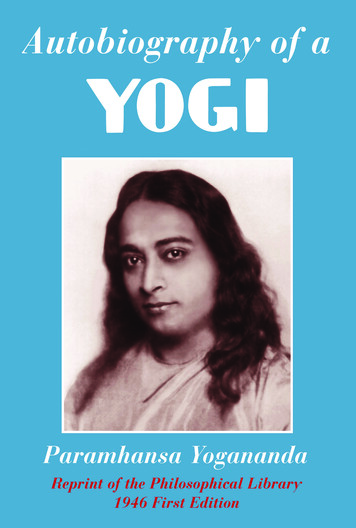
Transcription
AUTOBIOGRAPHY OF A YOGI
AUTOBIOGRAPHYOF AYOGIByParamhansa YoganandaWIT H A P REF AC E BYW. Y. Evans-Wentz, M.A., D. Litt., D. Sc.“Except ye see signs and wonders,ye will not believe.”—John 4:48.THE PHILOSOPHICAL LIBRARYNEW YORK
Copyright, 1946, byParam h an sa Y ogan an da1 9 4 6 F i rs t E di t i o n , F i rs t Pri n t i n g P u bl i s h ed b yTHE PHILOSOPHICAL LIBRARY, INC.15 East 40t h St re e tNe w Y ork, N.Y .T hi s m anu s c r i p t w a s c o m p a red t o el ec t ro n i c s ourc es c rea ted b yP r o j e c t Gu t e n b erg a n d el ec t ro n i c a n d p ri n t s ourc es c rea ted b yCr ys t al C lar it y P u b l i s h ers . T h e dra f t y o u a re rea di n g n ow h a s n ot y etb e e n i n d ep en d en t l y p ro o f rea d o r revi ewed.
De dic at e d t o t he M e m o r y o fLUTHER BURBANKAn Amer i c an S a i n t
PREFACEBy W. Y. EVANS-WENTZ, M.A., D.Litt., D.Sc.Jesus College, Oxford; Author ofThe Tibetan Book of the Dead,Tibet’s Great Yogi Milarepa,Tibetan Yoga and Secret Doctrines, etc.T H E V A L U E of Yogananda’s Autobiography is greatly enhanced by the fact that it is one of the few books in Englishabout the wise men of India which has been written, not by ajournalist or foreigner, but by one of their own race andtraining—in short, a book about yogis by a yogi. As an eyewitness recountal of the extraordinary lives and powers ofmodern Hindu saints, the book has importance both timelyand timeless. To its illustrious author, whom I have had thepleasure of knowing both in India and America, may everyreader render due appreciation and gratitude. His unusuallife-document is certainly one of the most revealing of thedepths of the Hindu mind and heart, and of the spiritualwealth of India, ever to be published in the West.It has been my privilege to have met one of the sageswhose life-history is herein narrated—Sri Yukteswar Giri. Alikeness of the venerable saint appeared as part of the frontispiece of my Tibetan Yoga and Secret Doctrines.* It was atPuri, in Orissa, on the Bay of Bengal, that I encountered SriYukteswar. He was then the head of a quiet āshrama nearthe seashore there, and was chiefly occupied in the spiritualtraining of a group of youthful disciples. He expressed keeninterest in the welfare of the people of the United States andof all the Americas, and of England, too, and questioned me* Oxford University Press, 1935.[vii]
[viii]Prefaceconcerning the distant activities, particularly those in California, of his chief disciple, Paramhansa Yogananda, whom hedearly loved, and whom he had sent, in 1920, as his emissaryto the West.Sri Yukteswar was of gentle mien and voice, of pleasingpresence, and worthy of the veneration which his followersspontaneously accorded to him. Every person who knewhim, whether of his own community or not, held him in thehighest esteem. I vividly recall his tall, straight, ascetic figure,garbed in the saffron-colored garb of one who has renouncedworldly quests, as he stood at the entrance of the hermitageto give me welcome. His hair was long and somewhat curly,and his face bearded. His body was muscularly firm, butslender and well-formed, and his step energetic. He hadchosen as his place of earthly abode the holy city of Puri,whither multitudes of pious Hindus, representative of everyprovince of India, come daily on pilgrimage to the famedTemple of Jagannath, “Lord of the World.” It was at Purithat Sri Yukteswar closed his mortal eyes, in 1936, to thescenes of this transitory state of being and passed on, knowing that his incarnation had been carried to a triumphantcompletion. I am glad, indeed, to be able to record this testimony to the high character and holiness of Sri Yukteswar.Content to remain afar from the multitude, he gave himselfunreservedly and in tranquillity to that ideal life whichParamhansa Yogananda, his disciple, has now described forthe ages.W. Y. EVANS-WENTZ
Author’s AcknowledgmentsI am deeply indebted to Miss L. V. Pratt for her long editoriallabors over the manuscript of this book. My thanks are due also toMiss Ruth Zahn for preparation of the index, to Mr. C. RichardWright for permission to use extracts from his Indian travel diary,and to Dr. W. Y. Evans-Wentz for suggestions and encouragement.PARAMHANSA YOGANANDAOctober 28, 1945Encinitas, California
ContentsPreface, by W. Y. Evans-WentzList of Illustrations.vii.xivChapter.1.My Parents and Early Life2.Mother’s Death and the Amulet3.Saint with Two Bodies(Swami Pranabananda)4.3.16.23.31My Interrupted Flight Towardthe Himalayas .5.A “Perfume Saint” Performs his Wonders456.The Tiger Swami.7.The Levitating Saint8.53(Nagendra Nath Bhaduri) .63.70Cosmic Romance (Master Mahasaya) .80India’s Great Scientist and Inventor,Jagadis Chandra Bose .9.The Blissful Devotee and his[xi]
[xii]Autobiography of a Yogi10.I Meet my Master, Sri Yukteswar11.Two Penniless Boys in Brindaban12.Years in my Master’s Hermitage13.The Sleepless Saint(Ram Gopal Muzumdar).88.99.109.14215014.An Experience in Cosmic Consciousness15.The Cauliflower Robbery.15816.Outwitting the Stars.17017.Sasi and the Three Sapphires.18118.A Mohammedan Wonder-Worker.188(Afzal Khan)19.My Guru Appears Simultaneously inCalcutta and Serampore.19420.We Do Not Visit Kashmir.19821.We Visit Kashmir.20322.The Heart of a Stone Image.21323.My University Degree.22124.I Become a Monk of the Swami Order .22825.Brother Ananta and Sister Nalini .23726.The Science of Kriya Yoga .24327.Founding a Yoga School at Ranchi.25228.Kashi, Reborn and Rediscovered.26229.Rabindranath Tagore and ICompare Schools.268.273.28630.The Law of Miracles31.An Interview with the Sacred Mother(Kashi Moni Lahiri).
[xiii]Contents32.Rama is Raised from the Dead.29733.Babaji, the Yogi-Christ of Modern India30634.Materializing a Palace in the Himalayas31535.The Christlike Life of Lahiri Mahasaya32836.Babaji’s Interest in the West37.I Go to America38.Luther Burbank—.A Saint Amidst the Roses39.342.353.363.370Therese Neumann,the Catholic Stigmatist of Bavaria.380An Idyl in South India.38942.Last Days with my Guru.40343.The Resurrection of Sri Yukteswar.42044.With Mahatma Gandhi at Wardha .44145.The Bengali “Joy-Permeated Mother”.46140.I Return to India41.(Ananda Moyi Ma)46.The Woman Yogi who Never Eats(Giri Bala).467.479.48547.I Return to the West48.At Encinitas in California
IllustrationsFrontispieceMap of India . . . . . . . . . . . .My Father, Bhagabati Charan Ghosh.My Mother.Swami Pranabananda, “The Saint With Two Bodies”My Elder Brother, Ananta .Festival Gathering in the Courtyard of my Guru’sHermitage in Serampore.Nagendra Nath Bhaduri, “The Levitating Saint” .Myself at Age Six.Jagadis Chandra Bose, Famous Scientist .Two Brothers of Therese Neumann, at KonnersreuthMaster Mahasaya, the Blissful Devotee .Jitendra Mazumdar, my Companion on the “PennilessTest” at Brindaban.Swami Kebalananda, my Saintly Sanskrit Tutor .Ananda Moyi Ma, the “Joy-Permeated Mother” .Himalayan Cave Occupied by Babaji.Sri Yukteswar, my Master .Self-Realization Fellowship, Los Angeles 103114122
IllustrationsSelf-Realization Church of All Religions, HollywoodMy Guru’s Seaside Hermitage at Puri.My Sisters—Roma, Nalini, and Uma.Self-Realization Church of All Religions, San Diego .The Lord in His Aspect as Shiva.Yogoda Math , Hermitage at Dakshineswar .Ranchi School, Main Building .Kashi, Reborn and Rediscovered.Bishnu, Motilal Mukherji, my Father, Mr. Wright,T.N. Bose, Swami Satyananda .Group of Delegates to the International Congress ofReligious Liberals, Boston, 1920.A Guru and Disciple in an Ancient Hermitage.Babaji, the Yogi-Christ of Modern India .Lahiri Mahasaya.A Yoga Class in Washington, D.C. .Luther Burbank.Therese Neumann of Konnersreuth, Bavaria.The Taj Mahal at Agra .Shankari Mai Jiew, Only Living Disciple of the greatTrailanga Swami .Krishnananda with his Tame Lioness.Group on the Dining Patio of my Guru’s SeramporeHermitage .Miss Bletch, Mr. Wright, and myself—in Egypt .Rabindranath Tagore.Swami Keshabananda, at his Hermitage in BrindabanKrishna, Ancient Prophet of India.Mahatma Gandhi, at Wardha.Giri Bala, the Woman Yogi Who Never Eats.Group of Ranchi Students, with the Maharaja ofKasimbazar.My Guru and Myself, Calcutta, 1935.Mr. E. E. Dickinson of Los Angeles .Self-Realization Fellowship at Encinitas, California .My Father, in 1936 6493
[xvi]Autobiography of a YogiSwami Premananda, before the Self-RealizationChurch of All Religions in Washington, D. C.Speakers at a 1945 Interracial Meeting in SanFrancisco, California.493.493
AUTOBIOGRAPHY OF A YOGI
CHAPTER:1My Parents and Early Lifelong been a searchTconcomitant disciple-guruof Indian culture havefor ultimate verities and the* relationship. My own path ledme to a Christlike sage whose beautiful life was chiseled forthe ages. He was one of the great masters who are India’ssole remaining wealth. Emerging in every generation, theyhave bulwarked their land against the fate of Babylon andEgypt.I find my earliest memories covering the anachronistic features of a previous incarnation. Clear recollections came tome of a distant life, a yogi † amidst the Himalayan snows.These glimpses of the past, by some dimensionless link, alsoafforded me a glimpse of the future.The helpless humiliations of infancy are not banished frommy mind. I was resentfully conscious of not being able towalk or express myself freely. Prayerful surges arose withinme as I realized my bodily impotence. My strong emotionallife took silent form as words in many languages. Among theinward confusion of tongues, my ear gradually accustomeditself to the circumambient Bengali syllables of my people.The beguiling scope of an infant’s mind! adultly consideredlimited to toys and toes.Psychological ferment and my unresponsive body broughtme to many obstinate crying-spells. I recall the general familybewilderment at my distress. Happier memories, too, crowdHECHARACTERISTICFEATURES* Spiritual teacher; from Sanskrit root gur, to raise, to uplift.† A practitioner of yoga, “union,” ancient Indian science of meditation on God.3
4Autobiography of a Yogiin on me: my mother’s caresses, and my first attempts at lisping phrase and toddling step. These early triumphs, usuallyforgotten quickly, are yet a natural basis of self-confidence.My far-reaching memories are not unique. Many yogis areknown to have retained their self-consciousness without interruption by the dramatic transition to and from “life” and“death.” If man be solely a body, its loss indeed places the final period to identity. But if prophets down the millenniumsspake with truth, man is essentially of incorporeal nature.The persistent core of human egoity is only temporarily allied with sense perception.Although odd, clear memories of infancy are not extremely rare. During travels in numerous lands, I havelistened to early recollections from the lips of veracious menand women.I was born in the last decade of the nineteenth century,and passed my first eight years at Gorakhpur. This was mybirthplace in the United Provinces of northeastern India. Wewere eight children: four boys and four girls. I, Mukunda LalGhosh,* was the second son and the fourth child.Father and Mother were Bengalis, of the Kshatriya caste.†Both were blessed with saintly nature. Their mutual love,tranquil and dignified, never expressed itself frivolously. Aperfect parental harmony was the calm center for the revolving tumult of eight young lives.Father, Bhagabati Charan Ghosh, was kind, grave, attimes stern. Loving him dearly, we children yet observed acertain reverential distance. An outstanding mathematicianand logician, he was guided principally by his intellect. ButMother was a queen of hearts, and taught us only throughlove. After her death, Father displayed more of his inner tenderness. I noticed then that his gaze often metamorphosed into my mother’s.In Mother’s presence we tasted our earliest bitter-sweet acquaintance with the scriptures. Tales from the Mahabharata* My name was changed to Yogananda when I entered the ancient monasticSwami Order in 1914. My guru bestowed the religious title of Paramhansa onme in 1935 (see chapters 24 and 42).† Traditionally, the second caste of warriors and rulers.
My Parents and Early Life5and Ramayana * were resourcefully summoned to meet theexigencies of discipline. Instruction and chastisement wenthand in hand.A daily gesture of respect to Father was given by Mother’sdressing us carefully in the afternoons to welcome him homefrom the office. His position was similar to that of a vicepresident, in the Bengal-Nagpur Railway, one of India’s largecompanies. His work involved traveling, and our familylived in several cities during my childhood.Mother held an open hand toward the needy. Father wasalso kindly disposed, but his respect for law and order extended to the budget. One fortnight Mother spent, in feedingthe poor, more than Father’s monthly income.“All I ask, please, is to keep your charities within a reasonable limit.” Even a gentle rebuke from her husband wasgrievous to Mother. She ordered a hackney carriage, nothinting to the children at any disagreement.“Good-by; I am going away to my mother’s home.” Ancient ultimatum!We broke into astounded lamentations. Our maternaluncle arrived opportunely; he whispered to Father some sagecounsel, garnered no doubt from the ages. After Father hadmade a few conciliatory remarks, Mother happily dismissedthe cab. Thus ended the only trouble I
THE VALUE of Yogananda’s Autobiography is greatly en-hanced by the fact that it is one of the few books in English about the wise men of India which has been written, not by a journalist or foreigner, but by one of their own race and training—in short, a book about yogis by a yogi. As an eye- witness recountal of the extraordinary lives and powers of modern Hindu saints, the book has .
